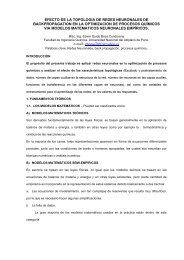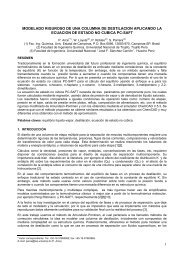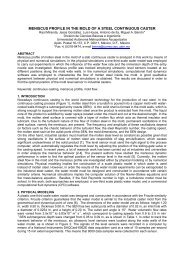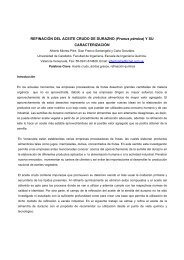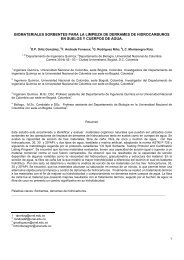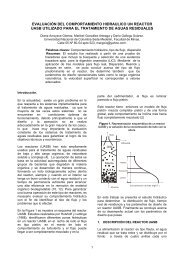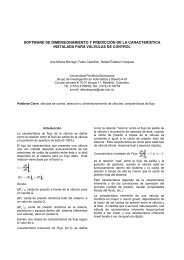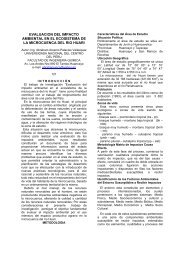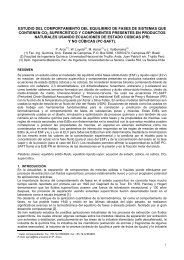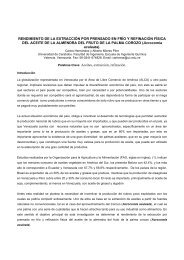degradation of agrochemicals in wastewaters by the photo-fenton ...
degradation of agrochemicals in wastewaters by the photo-fenton ...
degradation of agrochemicals in wastewaters by the photo-fenton ...
Create successful ePaper yourself
Turn your PDF publications into a flip-book with our unique Google optimized e-Paper software.
DEGRADATION OF AGROCHEMICALS IN WASTEWATERS BY THE PHOTO-FENTON<br />
PROCESS: EXPERIMENTAL STUDY USING UV MERCURY VAPOR LAMPS AND<br />
SOLAR IRRADIATION<br />
Antonio C.S.C. Teixeira 1 , Giselle Stollar, Roberto Guardani, Cláudio A.O. Nascimento<br />
University <strong>of</strong> São Paulo – Chemical Eng<strong>in</strong>eer<strong>in</strong>g Department<br />
Av. Pr<strong>of</strong>. Luciano Gualberto, tr. 3, 380 - 05508-900 - São Paulo – SP – Brazil – Fax: +55-11-3813-2380<br />
1<br />
E-mail: acscteix@usp.br<br />
Key Words: <strong>photo</strong>-Fenton, <strong>agrochemicals</strong>, pesticides; wastewater<br />
Introduction<br />
Pesticides can be present <strong>in</strong> wastewater from<br />
<strong>in</strong>dustry and farm work operations (r<strong>in</strong>se water from<br />
spray equipment and empty pesticide conta<strong>in</strong>ers,<br />
post-harvest wash<strong>in</strong>g <strong>of</strong> fruits and vegetables,<br />
etc.). 1 The <strong>in</strong>adequate management <strong>of</strong> <strong>the</strong>se toxic<br />
recalcitrant residues can cause contam<strong>in</strong>ation <strong>of</strong><br />
<strong>the</strong> soil and <strong>of</strong> subterranean and surface water<br />
sources. Social and legal demands for<br />
environmental safety require <strong>the</strong>se impacts be<br />
m<strong>in</strong>imized.<br />
In general, wastewater remediation <strong>by</strong> conventional<br />
treatments (flocculation, adsorption, <strong>in</strong>c<strong>in</strong>eration,<br />
etc.), while <strong>of</strong>ten efficient, <strong>of</strong>ten merely transfers<br />
pollutants from one phase to ano<strong>the</strong>r. 2 Also, <strong>the</strong><br />
presence <strong>of</strong> non-biodegradable substances<br />
precludes <strong>the</strong> use <strong>of</strong> conventional activated-sludge<br />
systems. These demands have fueled <strong>the</strong><br />
development <strong>of</strong> more effective and economically<br />
viable methods for pollution control and prevention.<br />
Several <strong>photo</strong>chemical advanced oxidation<br />
processes (AOPs) are known that can ra<strong>the</strong>r<br />
unselectively oxidize a wide range <strong>of</strong> organic<br />
pollutants with a diversity <strong>of</strong> chemical structures<br />
and functional groups. 2-4 Under favorable<br />
conditions, <strong>the</strong> total decomposition <strong>of</strong> <strong>the</strong> organic<br />
constituents <strong>of</strong> <strong>the</strong> pollutant to carbon dioxide and<br />
water, plus <strong>in</strong>organic salts <strong>of</strong> all heteroatoms o<strong>the</strong>r<br />
than oxygen, is achieved. 5 In <strong>the</strong> AOPs carried out<br />
<strong>in</strong> homogeneous solution, <strong>the</strong> absorption <strong>of</strong> light<br />
triggers <strong>photo</strong>chemical and/or chemical reactions<br />
that produce hydroxyl radicals (HO • ), which react<br />
with <strong>the</strong> majority <strong>of</strong> organic substances with low<br />
selectivity and at rates <strong>of</strong>ten approach<strong>in</strong>g <strong>the</strong><br />
diffusion-controlled limit. 6<br />
Among AOPs, <strong>the</strong> <strong>photo</strong>-Fenton reaction is<br />
considered most promis<strong>in</strong>g for <strong>the</strong> remediation <strong>of</strong><br />
wastewater conta<strong>in</strong><strong>in</strong>g a variety <strong>of</strong> toxic nonbiodegradable<br />
organic compounds. 7 In <strong>the</strong> Fenton<br />
reaction, Fe(II) is oxidized to Fe(III), and H 2 O 2 is<br />
reduced to <strong>the</strong> hydroxide ion and <strong>the</strong> hydroxyl<br />
radical:<br />
Fe(II)+H 2 O 2<br />
⎯⎯→<br />
Fe(III)+HO • +OH − (1)<br />
In <strong>the</strong> absence <strong>of</strong> light, Fe(III) is reduced back to<br />
Fe(II) <strong>by</strong> hydrogen peroxide:<br />
Fe(III)+H 2 O 2 +H 2 O<br />
⎯⎯→<br />
Fe(II)+H 3 O + •−<br />
+HO 2<br />
(2)<br />
Reaction 2 is much slower than reaction 1, and<br />
ultimately determ<strong>in</strong>es <strong>the</strong> overall process rate. For<br />
<strong>the</strong> <strong>degradation</strong> <strong>of</strong> organic molecules, <strong>the</strong> optimum<br />
pH for <strong>the</strong> Fenton reaction is typically <strong>in</strong> <strong>the</strong> range<br />
3-4, and <strong>the</strong> optimum mass ratio Fe(II)/H 2 O 2 is 1.5. 8<br />
A more detailed description <strong>of</strong> <strong>the</strong>se reactions,<br />
consider<strong>in</strong>g hydrated iron-H 2 O 2 complexes,<br />
<strong>in</strong>clud<strong>in</strong>g rate constants and redox potentials is<br />
found <strong>in</strong> literature. 9<br />
Irradiation <strong>of</strong> Fenton systems with UV-visible<br />
irradiation strongly accelerates both Fenton and<br />
Fenton-like (H 2 O 2 /Fe(III)) reactions, improv<strong>in</strong>g<br />
<strong>degradation</strong> rates. 7 The optimum pH range is 2-4,<br />
<strong>in</strong> which <strong>the</strong> predom<strong>in</strong>ant Fe(III) species <strong>in</strong> aqueous<br />
solution is Fe(OH) 2+ , which absorbs out to 410 nm,<br />
undergo<strong>in</strong>g a relatively efficient <strong>in</strong>ternal light<strong>in</strong>duced<br />
redox reaction, yield<strong>in</strong>g hydroxyl radicals<br />
and regenerat<strong>in</strong>g Fe(II) (reaction 3): 10<br />
Fe(OH) 2+<br />
⎯⎯→<br />
hν<br />
Fe(II)+HO • (3)<br />
Also, <strong>photo</strong>chemical reactions <strong>of</strong> Fe(III)-L<br />
(L=organic <strong>in</strong>termediates, specially acids) are<br />
reported. These species exhibit strong ligand-tometal<br />
charge absorption bands <strong>in</strong> <strong>the</strong> near-UV and<br />
visible region <strong>of</strong> <strong>the</strong> spectrum (reaction 4):<br />
Fe(III)-L<br />
⎯⎯→<br />
h ν [Fe(III)-L] ∗ ⎯⎯→<br />
hν<br />
Fe(II)+L • (4)<br />
One <strong>of</strong> <strong>the</strong> common drawbacks <strong>of</strong> <strong>photo</strong>chemical<br />
processes is <strong>the</strong> great demand <strong>of</strong> electrical energy<br />
for UV lamps. 7 This can easily represent 60% <strong>of</strong> <strong>the</strong><br />
total operat<strong>in</strong>g expense <strong>of</strong> a lamp-based<br />
<strong>photo</strong>chemical reactor. A very <strong>in</strong>terest<strong>in</strong>g<br />
alternative is <strong>the</strong> use <strong>of</strong> solar light, which looks<br />
extremely attractive at sites with annual global<br />
<strong>in</strong>solation <strong>of</strong> 1700 kWh m -2 or higher. 2 The solar<br />
radiation <strong>in</strong>cident on <strong>the</strong> earth’s surface is split up<br />
<strong>in</strong>to <strong>the</strong> direct-beam radiation and <strong>the</strong> diffuse<br />
radiation. 11 Direct radiation is <strong>the</strong> solar radiation<br />
that reaches <strong>the</strong> surface without be<strong>in</strong>g scattered or
absorbed <strong>in</strong> <strong>the</strong> atmosphere. The diffuse<br />
component refers to scattered radiation.<br />
Comprehensive articles have been published for<br />
<strong>the</strong> last years concern<strong>in</strong>g ongo<strong>in</strong>g R&D directed<br />
towards solar <strong>photo</strong>catalytic reactors. 12<br />
Some papers have appeared <strong>in</strong> <strong>the</strong> literature<br />
describ<strong>in</strong>g <strong>the</strong> use <strong>of</strong> <strong>the</strong> <strong>photo</strong>-Fenton process for<br />
<strong>the</strong> <strong>degradation</strong> <strong>of</strong> waterborne pesticides. The<br />
<strong>degradation</strong> <strong>of</strong> triaz<strong>in</strong>e herbicides, 1 methylparathion,<br />
3 fenuron 13 , and diuron 1 are known<br />
examples. In this work, <strong>the</strong> variables <strong>in</strong>volved <strong>in</strong> <strong>the</strong><br />
<strong>photo</strong>-Fenton reaction, namely Fe(II) and H 2 O 2<br />
concentrations, radiation source, and pesticide<br />
chemical structure, were <strong>in</strong>vestigated <strong>in</strong> detail.<br />
circulated at 30 L m<strong>in</strong> -1 <strong>by</strong> means <strong>of</strong> a centrifugal<br />
pump. Each tube was positioned at <strong>the</strong> l<strong>in</strong>e-focus <strong>of</strong><br />
a parabolic trough collector <strong>of</strong> 0.26 m 2 reflect<strong>in</strong>g<br />
surface. The PTR was mounted on a fixed platform<br />
<strong>in</strong>cl<strong>in</strong>ed 23º (from ground) and fac<strong>in</strong>g North,<br />
accord<strong>in</strong>g to <strong>the</strong> latitude (23º32.0’S) and longitude<br />
(46º37.0’W) <strong>of</strong> São Paulo (Brazil).<br />
Methodology<br />
A schematic view <strong>of</strong> <strong>the</strong> bench-scale <strong>photo</strong>chemical<br />
reactor used <strong>in</strong> this work is shown <strong>in</strong> Fig. 1. The<br />
equipment consisted <strong>of</strong> an annular <strong>photo</strong>chemical<br />
reactor (Ace Glass, model 7863-20) with a net<br />
volume <strong>of</strong> 0.85 L, connected to a 1-L jacketed glass<br />
reservoir.<br />
Figure 1 - Schematic view <strong>of</strong> <strong>the</strong> bench-scale<br />
<strong>photo</strong>chemical reactor. M, rotat<strong>in</strong>g impeller connected to<br />
an agitator device. T, temperature sensor connected to a<br />
digital <strong>in</strong>dicator. pH, electrode connected to a digital pH<br />
meter.<br />
Two liters <strong>of</strong> <strong>the</strong> pesticide solution was circulated<br />
through <strong>the</strong> reactor and <strong>the</strong> tank at 0.025 L s -1 , and<br />
its temperature was controlled <strong>by</strong> means <strong>of</strong> a<br />
<strong>the</strong>rmo-regulated bath. The light source was a<br />
medium pressure mercury vapor lamp (Philips,<br />
model HPLN) placed <strong>in</strong>side a quartz-well (cutt<strong>in</strong>g<strong>of</strong>f<br />
radiation <strong>of</strong> wavelength shorter than 280 nm).<br />
Ferrioxalate act<strong>in</strong>ometry measurements 9 <strong>in</strong>dicated<br />
average polychromatic <strong>photo</strong>n fluxes <strong>of</strong> 2.2× 10 19<br />
and 4.6× 10 19 <strong>photo</strong>ns s -1 for 125 and 400-W<br />
lamps, respectively.<br />
A schematic view <strong>of</strong> <strong>the</strong> concentrat<strong>in</strong>g parabolictrough<br />
reactor (PTR) used <strong>in</strong> <strong>the</strong> solar experiments<br />
is shown <strong>in</strong> Fig. 2. The apparatus consisted <strong>of</strong> n<strong>in</strong>e<br />
flow-through borosilicate glass tubes <strong>in</strong> series,<br />
connected to a 10-L reservoir. 5 L <strong>of</strong> pesticide<br />
aqueous solution was treated <strong>in</strong> each batch,<br />
Figure 2 - Schematic view <strong>of</strong> <strong>the</strong> concentrat<strong>in</strong>g parabolictrough<br />
reactor (PTR), show<strong>in</strong>g one tube. M, rotat<strong>in</strong>g<br />
impeller connected to an agitator device. T, temperature<br />
sensor connected to a digital <strong>in</strong>dicator. pH, electrode<br />
connected to a digital pH meter.<br />
The experimental procedure was <strong>the</strong> same <strong>in</strong> all<br />
runs. The pesticide aqueous solution, prepared<br />
from commercial agrochemical formulations or from<br />
<strong>the</strong> active compounds, was firstly <strong>in</strong>troduced <strong>in</strong>to<br />
<strong>the</strong> reactor. pH was adjusted at 3.0 <strong>by</strong> <strong>the</strong> addition<br />
<strong>of</strong> H 2 SO 4 , and <strong>the</strong>n cont<strong>in</strong>uously monitored.<br />
Weighed amount <strong>of</strong> solid FeSO 4 .7H 2 O (>98%,<br />
Sigma Aldrich) was added, and <strong>the</strong> system was<br />
exposed to light. The H 2 O 2 solution, prepared us<strong>in</strong>g<br />
an analytical grade stock-solution (30% w/w <strong>in</strong><br />
water, Merck), was <strong>in</strong>troduced at a controlled flow<br />
rate (13.3 µ L s -1 ), <strong>by</strong> means <strong>of</strong> a peristaltic pump<br />
(Ismatec-IPC). In <strong>the</strong> follow<strong>in</strong>g sections, [H 2 O 2 ]<br />
refer to <strong>the</strong> hydrogen peroxide concentration <strong>of</strong> <strong>the</strong><br />
feed solution, and [Fe(II)] to <strong>the</strong> iron concentration<br />
<strong>of</strong> <strong>the</strong> aqueous solution <strong>in</strong> <strong>the</strong> reactor.<br />
Ten-milliliter samples were taken from <strong>the</strong> reservoir<br />
at specified times for <strong>the</strong> characterization <strong>of</strong><br />
pollutant <strong>degradation</strong>. The chemical oxygen<br />
demand (COD) <strong>of</strong> each sample was measured <strong>by</strong><br />
<strong>the</strong> closed-reflux colorimetric method. 14 The<br />
concentration <strong>of</strong> dissolved organic carbon (DOC)<br />
was measured us<strong>in</strong>g <strong>the</strong> Shimadzu 5000A<br />
equipment. A quench<strong>in</strong>g solution conta<strong>in</strong><strong>in</strong>g KI,<br />
Na 2 SO 3 and NAOH (0.1 mol L -1 each) was added to<br />
<strong>the</strong> samples <strong>in</strong> <strong>the</strong> proportion 5:2 v/v<br />
(sample:solution) <strong>in</strong> order to decompose residual<br />
H 2 O 2 and precipitate iron species. All samples were<br />
filtered through a 0.22- µ m membrane before DOC<br />
analysis. The biochemical oxygen demand (BOD 5 )<br />
<strong>of</strong> <strong>the</strong> f<strong>in</strong>al treated solution was measured <strong>by</strong> <strong>the</strong><br />
respirometric method 14 us<strong>in</strong>g <strong>the</strong> Oxitop IS 12<br />
manometric respirometer (WTW).
The Laboratory <strong>of</strong> Micrometeorology (Astronomical<br />
and Geophysical Institute, University <strong>of</strong> São Paulo)<br />
provided solar radiation data. Global radiation was<br />
measured every five m<strong>in</strong>utes with a pyranometer<br />
(Eppley, model PBW) <strong>in</strong> <strong>the</strong> range 285 to 2800 nm.<br />
The diffuse component was measured <strong>by</strong> means <strong>of</strong><br />
a pyranometer (Eppley, model PSP) with a shad<strong>in</strong>g<br />
r<strong>in</strong>g to elim<strong>in</strong>ate direct radiation. Fig. 3 shows a<br />
typical solar irradiance pr<strong>of</strong>ile, and <strong>the</strong><br />
correspond<strong>in</strong>g accumulated radiant energy.<br />
Ferrioxalate act<strong>in</strong>ometry <strong>in</strong>dicated an average<br />
polychromatic <strong>photo</strong>n flux equal to 1.9× 10 21<br />
<strong>photo</strong>ns s -1 . All solar experiments were carried out<br />
with<strong>in</strong> a few weeks, so that seasonal effects were<br />
not important.<br />
irradiance (W m -2 )<br />
1000<br />
800<br />
600<br />
400<br />
200<br />
0<br />
12 13 14 15 16 17 18<br />
local time (h)<br />
10000<br />
8000<br />
6000<br />
4000<br />
2000<br />
0<br />
accumulated radiant<br />
energy (kJ m -2 )<br />
Figure 3 - Direct and diffuse (broken l<strong>in</strong>es) radiation<br />
measurements (left ord<strong>in</strong>ate axis) and correspond<strong>in</strong>g<br />
accumulated radiant energy (right ord<strong>in</strong>ate axis).<br />
Results and Discussion<br />
The <strong>photo</strong>-Fenton <strong>degradation</strong> <strong>of</strong> three<br />
<strong>agrochemicals</strong> was estudied: tebuconazole<br />
(fungicide), methamidophos (<strong>in</strong>secticide/acaricide),<br />
and clomazone (herbicide).<br />
1. experiments with tebuconazole<br />
Aqueous solutions (1 g L -1 ) <strong>of</strong> tebuconazole ((RS)-<br />
1-p-chlorophenyl-4,4-dimethyl-3-(1H-1,2,4-triazol-1-<br />
ylmethyl)pentan-3-ol, Fig. 4), prepared with <strong>the</strong><br />
formulation Folicur ® PE (wettable powder, 25% w/v<br />
<strong>in</strong> active compound, Bayer CropScience), were<br />
used. These solutions had COD 0 =224±27 mg L -1 ;<br />
DOC 0 =70±5 mg L -1 ; BOD 5 =187 mg L -1 . The results<br />
<strong>of</strong> <strong>the</strong> experiments are shown <strong>in</strong> Figs. 5 to 8.<br />
Cl−<br />
−<br />
−<br />
OH<br />
2− − −<br />
CH CH C C CH<br />
2 3<br />
N<br />
CH 2<br />
CH 3<br />
N<br />
CH 3<br />
Figure 4 - Molecular structure <strong>of</strong> tebuconazole.<br />
N<br />
The <strong>photo</strong>-Fenton reaction (Fig. 5, experiment P8-<br />
L) showed a rapid removal <strong>of</strong> DOC (89%) and COD<br />
(86%). The <strong>in</strong>crease <strong>in</strong> <strong>in</strong>organic carbon<br />
concentration (3 to 18 mg L -1 ) and <strong>the</strong> variation <strong>of</strong><br />
pH (3 to 2.62, associated with <strong>the</strong> formation <strong>of</strong><br />
organic acids) suggested <strong>the</strong> m<strong>in</strong>eralization <strong>of</strong><br />
tebuconazole and <strong>in</strong>ert compounds. The dark<br />
Fenton process (experiment P13-L), on <strong>the</strong> o<strong>the</strong>r<br />
hand, showed a DOC removal <strong>of</strong> only 11%. In this<br />
case, <strong>the</strong> generation <strong>of</strong> HO • radicals slowed down<br />
after reaction 1, and <strong>the</strong> addition <strong>of</strong> relatively large<br />
amounts <strong>of</strong> iron would be required <strong>in</strong> order to<br />
degrade <strong>the</strong> pollutant. 7,8<br />
DOC (mg L -1 )<br />
100<br />
80<br />
60<br />
40<br />
20<br />
0<br />
0 50 100 150 200<br />
irradiation time (m<strong>in</strong>utes)<br />
P8-L<br />
P13-L<br />
Figure 5 - Results <strong>of</strong> <strong>the</strong> experiments carried out with<br />
tebuconazole at 30 o C, 400-W lamp. P8-L (<strong>photo</strong>-Fenton;<br />
[H 2 O 2 ]=0.5 mol L -1 ; [Fe(II)]=0.0005 mol L -1 ); P13-L<br />
(Fenton; [H 2 O 2 ]=0.5 mol L -1 ; [Fe(II)]=0.0005 mol L -1 ).<br />
DOC (mg L -1 )<br />
COD (mg L -1 )<br />
100<br />
80<br />
60<br />
40<br />
20<br />
0<br />
250<br />
200<br />
150<br />
100<br />
50<br />
0<br />
0 50 100 150 200<br />
irradiation time (m<strong>in</strong>utes)<br />
0 50 100 150 200<br />
irradiation time (m<strong>in</strong>utes)<br />
P9-L<br />
P12-L<br />
P9-L<br />
P12-L<br />
Figure 6 - Results <strong>of</strong> <strong>the</strong> <strong>photo</strong>-Fenton experiments<br />
carried out with tebuconazole, 400-W lamp. P9-L (30 o C;<br />
[H 2 O 2 ]=0.05 mol L -1 ; [Fe(II)]=0.0005 mol L -1 ); P12-L<br />
(50 o C; [H 2 O 2 ]=0.05 mol L -1 ; [Fe(II)]=0.0005 mol L -1 ).
Therefore, irradiation <strong>of</strong> <strong>the</strong> Fenton system not only<br />
regenerated Fe(II), <strong>the</strong> crucial catalytic species <strong>in</strong><br />
<strong>the</strong> Fenton reaction (reactions 3 and 4), but also<br />
produced an additional HO • radical, <strong>the</strong> species<br />
responsible for oxidative cha<strong>in</strong> reactions. Moreover,<br />
s<strong>in</strong>ce Fe(II) was regenerated <strong>by</strong> light, <strong>the</strong> <strong>photo</strong>-<br />
Fenton process consumed less H 2 O 2 and required<br />
only catalytic amounts <strong>of</strong> Fe(II).<br />
Fig. 6 shows that DOC-time curves were virtually<br />
<strong>the</strong> same at 30 and 50 o C (experiments P9-L and<br />
P12-L). In experiment P12-L, <strong>the</strong> concentration <strong>of</strong><br />
organic compounds that could be oxidized at any<br />
time should be smaller, while <strong>the</strong> carbon balance <strong>in</strong><br />
both experiments was ra<strong>the</strong>r similar. In spite <strong>of</strong> <strong>the</strong><br />
fact that reactions 3 and 4 are less sensitive to<br />
temperature, 6,7,10 this could suggest different<br />
reaction pathways at each temperature.<br />
Fig. 7 <strong>in</strong>dicates that <strong>in</strong>creas<strong>in</strong>g [H 2 O 2 ] <strong>in</strong> <strong>the</strong> range<br />
0.01-0.1 mol L -1 had not a significant effect. For<br />
[H 2 O 2 ]=0.5 mol L -1 (experiment P8-L), DOC and<br />
COD removals <strong>of</strong> 68 and 73%, respectively, were<br />
obta<strong>in</strong>ed <strong>in</strong> <strong>the</strong> first 60 m<strong>in</strong>utes. DOC and COD<br />
percent removals after 180 m<strong>in</strong>utes were about<br />
90%, associated with a rapid variation <strong>in</strong> pH values<br />
from 3.00 to 2.62, measured after 30 m<strong>in</strong>utes.<br />
Fig 7. also shows that a five-fold <strong>in</strong>crease <strong>in</strong> [Fe(II)]<br />
did not seem to have a significant effect on DOC<br />
and COD-time-evolution. This behavior could be<br />
attributed to <strong>the</strong> <strong>photo</strong>catalytic effect. 7<br />
BOD 5 was determ<strong>in</strong>ed for samples taken at t=0 and<br />
t=180 m<strong>in</strong>utes for a <strong>photo</strong>-Fenton experiment<br />
carried at 30 o C, [H 2 O 2 ]=0.055 mol L -1 , and<br />
[Fe(II)]=0.00055 mol L -1 . Fig. 8 shows a f<strong>in</strong>al COD<br />
removal <strong>of</strong> 66%, along with an almost five-fold<br />
<strong>in</strong>crease <strong>in</strong> BOD 5 . The BOD 5 /COD ratio varied from<br />
2.7 to 36%. The <strong>in</strong>creased biodegradability was <strong>of</strong><br />
great importance, <strong>in</strong> view <strong>of</strong> <strong>the</strong> use <strong>of</strong> <strong>the</strong> <strong>photo</strong>-<br />
Fenton reaction as a prelim<strong>in</strong>ary step prior to a<br />
conventional activated-sludge biological treatment.<br />
COD or BOD5 (mg L -1 )<br />
250<br />
200<br />
150<br />
100<br />
50<br />
0<br />
186.5<br />
63.5<br />
t=0<br />
t=180 m<strong>in</strong>utes<br />
COD BOD 5<br />
5<br />
23<br />
DOC (mg L -1 )<br />
COD (mg L -1 )<br />
100<br />
80<br />
60<br />
40<br />
20<br />
0<br />
250<br />
200<br />
150<br />
100<br />
50<br />
0<br />
0 50 100 150 200<br />
irradiation time (m<strong>in</strong>utes)<br />
0 50 100 150 200<br />
irradiation time (m<strong>in</strong>utes)<br />
P6-L<br />
P8-L<br />
P9-L<br />
PE1<br />
PE3<br />
P6-L<br />
P8-L<br />
P9-L<br />
PE1<br />
PE3<br />
Figure 8 – Results <strong>of</strong> <strong>the</strong> <strong>photo</strong>-Fenton experiment<br />
carried out with tebuconazole at 30 o C, [H 2 O 2 ]=0.055 mol<br />
L -1 ; [Fe(II)]=0.00055 mol L -1 , 400-W lamp.<br />
2. experiments with methamidophos<br />
The experiments with methamidophos ((RS)-O,Sdimethyl<br />
phosphoramidothioate, Fig. 9), were<br />
carried out with an aqueous solution (1 mL L -1 ) <strong>of</strong><br />
<strong>the</strong> formulation Tamaron ® BR (concentrated liquid<br />
emulsion, 60% w/v <strong>in</strong> active compound, Bayer<br />
CropScience), which had COD 0 =864±12 mg L -1 ;<br />
DOC 0 =245±8 mg L -1 ; and BOD 5 =5 mg L -1 . The<br />
results are presented <strong>in</strong> Fig. 10.<br />
O<br />
NH 2<br />
P<br />
O−CH 3<br />
S−CH 3<br />
Figure 9 - Molecular structure <strong>of</strong> methamidophos.<br />
Figure 7 - Results <strong>of</strong> <strong>the</strong> <strong>photo</strong>-Fenton experiments<br />
carried out with tebuconazole at 30 o C, 400-W lamp. P6-L<br />
([H 2 O 2 ]=0.05 mol L -1 ; Fe(II)]=0.0028 mol L -1 ); P8-L<br />
([H 2 O 2 ]=0.5 mol L -1 ; Fe(II)]=0.0005 mol L -1 ); P9-L<br />
([H 2 O 2 ]=0.05 mol L -1 ; Fe(II)]=0.0005 mol L -1 ); PE1<br />
([H 2 O 2 ]=0.1 mol L -1 ; Fe(II)]=0.00055 mol L -1 ); PE3<br />
([H 2 O 2 ]=0.01 mol L -1 ; Fe(II)]=0.00055 mol L -1 ).<br />
Fig. 10 shows a slow decrease <strong>of</strong> DOC values with<br />
time for experiments TM1 and TM2 (f<strong>in</strong>al removals<br />
<strong>of</strong> 6 and 18%, respectively). A huge <strong>in</strong>crease <strong>in</strong><br />
[H 2 O 2 ] toge<strong>the</strong>r with an <strong>in</strong>crease <strong>in</strong> [Fe(II)] were<br />
needed to obta<strong>in</strong> <strong>the</strong> behavior shown after 60<br />
m<strong>in</strong>utes <strong>in</strong> experiment TM3, with 82% carbon<br />
removal after 180 m<strong>in</strong>utes. These results also<br />
suggest <strong>the</strong> generation <strong>of</strong> stable <strong>degradation</strong><br />
products without a substantial variation <strong>in</strong> DOC
concentration, which could be ma<strong>in</strong>ly acids, s<strong>in</strong>ce<br />
pH varied <strong>in</strong> <strong>the</strong> ranges 3.03-2.47 (TM1), and 3.04-<br />
2.01 (TM2). In experiment TM3, pH rema<strong>in</strong>ed<br />
virtually constant, due to <strong>the</strong> excess <strong>of</strong> H 2 O 2 , and<br />
faster pollutant m<strong>in</strong>eralization.<br />
400<br />
DOC (mg L -1 )<br />
300<br />
200<br />
100<br />
0<br />
0 50 100 150 200<br />
irradiation time (m<strong>in</strong>utes)<br />
TM1<br />
TM2<br />
TM3<br />
Figure 10 - Results <strong>of</strong> <strong>the</strong> <strong>photo</strong>-Fenton experiments<br />
carried out with methamidophos at 30 o C, 400-W lamp.<br />
TM1 ([H 2 O 2 ]=0.055 mol L -1 ; [Fe(II)]=0.00055 mol L -1 );<br />
TM2 ([H 2 O 2 ]=0.55 mol L -1 ; [Fe(II)]=0.00055 mol L -1 ); TM3<br />
([H 2 O 2 ]=8 mol L -1 ; [Fe(II)]=0.001 mol L -1 ).<br />
The comparison <strong>of</strong> COD results <strong>in</strong> Figs. 7 and 10<br />
suggest that <strong>the</strong> pr<strong>in</strong>cipal mechanisms <strong>of</strong> reaction<br />
<strong>of</strong> hydroxyl radicals with organic compounds 9<br />
seemed to be less operative <strong>in</strong> <strong>the</strong> case <strong>of</strong><br />
methamidophos, ow<strong>in</strong>g to its recalcitrance. In fact,<br />
a small <strong>in</strong>crease <strong>in</strong> [H 2 O 2 ] had a more pronounced<br />
effect on tebuconazole <strong>degradation</strong>.<br />
3. experiments with clomazone<br />
In <strong>the</strong> case <strong>of</strong> clomazone (2-(2-chlorobenzyl)-4,4-<br />
dimethyl-1,2-oxazolid<strong>in</strong>-3-one, Fig. 11), aqueous<br />
solutions (0.185 g L -1 ) <strong>of</strong> <strong>the</strong> active compound (91%<br />
w/v, Clariant) were used. These solutions had<br />
COD 0 =271±35 mg L -1 and DOC 0 =97±10 mg L -1 . A<br />
standard 24-h toxicity test with Artemia sp nauplii 15<br />
resulted <strong>in</strong> CL 50 =84 mg L -1 .<br />
O<br />
CH 3<br />
−<br />
CH 3<br />
O<br />
Cl<br />
N−CH 2−<br />
Figure 11 - Molecular structure <strong>of</strong> clomazone.<br />
Experiments were carried out accord<strong>in</strong>g to a<br />
Doehlert uniform experimental design, 16 <strong>in</strong> which<br />
<strong>the</strong> effects <strong>of</strong> <strong>the</strong> molar ratio H 2 O 2 :C and [Fe(II)]<br />
were studied at a constant <strong>photo</strong>n flux (2.2 × 10 19<br />
<strong>photo</strong>ns s -1 , 125-W lamp). The experimental po<strong>in</strong>ts<br />
can be represented as <strong>the</strong> apexes and <strong>the</strong> center <strong>of</strong><br />
a hexagon (Fig. 12).<br />
Figure 12 - Graphical representation <strong>of</strong> <strong>the</strong> Doehlert<br />
uniform array. Variables X 1 and X 2 are normalized. The<br />
experiment numbers are <strong>in</strong>dicated near <strong>the</strong> apexes and<br />
<strong>the</strong> center <strong>of</strong> <strong>the</strong> hexagon.<br />
Figs. 13 to 15 compare <strong>the</strong> results <strong>of</strong> <strong>the</strong><br />
experiments <strong>in</strong> which [Fe(II)] was held constant at<br />
different levels. At [Fe(II)]=0.0001 mol L -1<br />
(experiments CLZ-L4 and CLZ-L5, Fig. 13), <strong>the</strong><br />
irradiation time, <strong>in</strong> m<strong>in</strong>utes, required to achieve a<br />
DOC removal <strong>of</strong> 50% relative to <strong>the</strong> <strong>in</strong>itial DOC (t 50 )<br />
varied from 38 to 21 m<strong>in</strong>utes when H 2 O 2 :C varied<br />
from 1.625 to 3.875, respectively. DOC removals<br />
after 180 m<strong>in</strong>utes were about 88%. COD-time<br />
curves behaved similarly. In experiment CLZ-L5,<br />
pH decreased from 3.05 to 2.44.<br />
DOC (mg L -1 )<br />
COD (mg L -1 )<br />
120<br />
100<br />
80<br />
60<br />
40<br />
20<br />
0<br />
400<br />
300<br />
200<br />
100<br />
0<br />
0 50 100 150 200<br />
irradiation time (m<strong>in</strong>utes)<br />
0 50 100 150 200<br />
irradiation time (m<strong>in</strong>utes)<br />
CLZ-L4<br />
CLZ-L5<br />
CLZ-L4<br />
CLZ-L5<br />
Figure 13 - Results <strong>of</strong> <strong>the</strong> <strong>photo</strong>-Fenton experiments<br />
carried out with clomazone at 30 o C and [Fe(II)]=0.0001<br />
mol L -1 , 125-W lamp. CLZ-L4 (H 2 O 2 :C=1.625); CLZ-L5<br />
(H 2 O 2 :C=3.875).<br />
Fig. 14 ([Fe(II)]=0.00055 mol L -1 ) shows that a 5.5-<br />
fold <strong>in</strong>crease <strong>in</strong> peroxide concentration enabled fast<br />
pesticide <strong>degradation</strong>. t 50 varied from 87 to 19 and<br />
8 m<strong>in</strong>utes when H 2 O 2 :C varied from 0.5 to 2.75 and<br />
5 (experiments CLZ-L3, CLZ-L1, and CLZ-L6,
espectively); <strong>the</strong> correspond<strong>in</strong>g DOC removals<br />
after 180 m<strong>in</strong>utes were 66, 88, and 88%,<br />
respectively.<br />
DOC (mg L -1 )<br />
COD (mg L -1 )<br />
120<br />
100<br />
80<br />
60<br />
40<br />
20<br />
0<br />
400<br />
300<br />
200<br />
100<br />
0<br />
0 50 100 150 200<br />
irradiation time (m<strong>in</strong>utes)<br />
0 50 100 150 200<br />
irradiation time (m<strong>in</strong>utes)<br />
CLZ-L1<br />
CLZ-L3<br />
CLZ-L6<br />
CLZ-L1<br />
CLZ-L3<br />
CLZ-L6<br />
Figure 14 - Results <strong>of</strong> <strong>the</strong> <strong>photo</strong>-Fenton experiments<br />
carried out with clomazone at 30 o C and [Fe(II)]=0.00055<br />
mol L -1 , 125-W lamp. CLZ-L1 (H 2 O 2 :C=2.75); CLZ-L3<br />
(H 2 O 2 :C=0.5); CLZ-L6 (H 2 O 2 :C=5).<br />
At <strong>the</strong> maximum Fe(II) concentration, Fig. 15 shows<br />
no remarkable modification <strong>of</strong> DOC and COD-time<br />
curves was observed when H 2 O 2 :C varied from<br />
1.625 to 3.875 (experiments CLZ-L2 and CLZ-L7,<br />
respectively). Total m<strong>in</strong>eralization <strong>of</strong> <strong>the</strong> pesticide<br />
was achieved <strong>in</strong> <strong>the</strong> first 30 m<strong>in</strong>utes <strong>in</strong> both cases.<br />
The <strong>photo</strong>-Fenton <strong>degradation</strong> <strong>of</strong> clomazone should<br />
be less susceptible to peroxide concentration at<br />
high [Fe(II)] tak<strong>in</strong>g <strong>in</strong>to account <strong>the</strong> importance <strong>of</strong><br />
<strong>the</strong> <strong>the</strong>rmal Fenton reactions.<br />
Figs. 16 and 17 compare <strong>the</strong> results <strong>of</strong> <strong>the</strong><br />
experiments <strong>in</strong> which H 2 O 2 :C was held constant at<br />
H 2 O 2 :C=1.625. The <strong>in</strong>crease <strong>in</strong> <strong>the</strong> Fe(II)<br />
concentration from 0.0001 to 0.001 mol L -1 led to a<br />
decrease <strong>in</strong> t 50 from 38 to 6 m<strong>in</strong>utes, and to an<br />
<strong>in</strong>crease <strong>in</strong> DOC removal after 180 m<strong>in</strong>utes <strong>of</strong><br />
irradiation from 88 to 100% (experiments CLZ-L4<br />
and CLZ-L2, respectively).<br />
DOC (mg L -1 )<br />
120<br />
100<br />
80<br />
60<br />
40<br />
20<br />
0<br />
0 50 100 150 200<br />
irradiation time (m<strong>in</strong>utes)<br />
CLZ-L2<br />
CLZ-L4<br />
DOC (mg L -1 )<br />
120<br />
100<br />
80<br />
60<br />
40<br />
20<br />
CLZ-L2<br />
CLZ-L7<br />
COD (mg L -1 )<br />
400<br />
300<br />
200<br />
100<br />
CLZ-L2<br />
CLZ-L4<br />
0<br />
0 50 100 150 200<br />
irradiation time (m<strong>in</strong>utes)<br />
0<br />
0 50 100 150 200<br />
irradiation time (m<strong>in</strong>utes)<br />
COD (mg L -1 )<br />
400<br />
300<br />
200<br />
100<br />
0<br />
0 50 100 150 200<br />
irradiation time (m<strong>in</strong>utes)<br />
CLZ-L2<br />
CLZ-L7<br />
Figure 15 - Results <strong>of</strong> <strong>the</strong> <strong>photo</strong>-Fenton experiments<br />
carried out with clomazone at 30 o C and [Fe(II)]=0.001<br />
mol L -1 , 125-W lamp. CLZ-L2 (H 2 O 2 :C=1.625); CLZ-L7<br />
(H 2 O 2 :C=3.875).<br />
Figure 16 - Results <strong>of</strong> <strong>the</strong> <strong>photo</strong>-Fenton experiments<br />
carried out with clomazone at 30 o C and H 2 O 2 :C=1.625,<br />
125-W lamp. CLZ-L2 ([Fe(II)]=0.001 mol L -1 ); CLZ-L4<br />
([Fe(II)]=0.0001 mol L -1 ).<br />
A similar but less remarkable behavior was<br />
obta<strong>in</strong>ed at H 2 O 2 :C=3.875 (Fig. 17). t 50 varied from<br />
21 to 8 m<strong>in</strong>utes, and DOC removal after 180<br />
m<strong>in</strong>utes <strong>of</strong> irradiation <strong>in</strong>creased from 89 to 100%<br />
(experiments CLZ-L5 and CLZ-L7, respectively).<br />
These results suggested that <strong>the</strong> <strong>photo</strong>-Fenton<br />
<strong>degradation</strong> <strong>of</strong> clomazone <strong>in</strong> aqueous solution was<br />
less dependent <strong>of</strong> Fe(II) concentration when<br />
H 2 O 2 :C was at <strong>the</strong> maximum level. Moreover, <strong>the</strong><br />
effect <strong>of</strong> [Fe(II)] on <strong>the</strong> <strong>in</strong>itial pollutant <strong>degradation</strong>
ate seemed to be more important than on <strong>the</strong> long<br />
term COD removal.<br />
DOC (mg L -1 )<br />
COD (mg L -1 )<br />
120<br />
100<br />
80<br />
60<br />
40<br />
20<br />
0<br />
400<br />
300<br />
200<br />
100<br />
0<br />
0 50 100 150 200<br />
irradiation time (m<strong>in</strong>utes)<br />
0 50 100 150 200<br />
irradiation time (m<strong>in</strong>utes)<br />
CLZ-L5<br />
CLZ-L7<br />
CLZ-L5<br />
CLZ-L7<br />
Figure 17 - Results <strong>of</strong> <strong>the</strong> <strong>photo</strong>-Fenton experiments<br />
carried out with clomazone at 30 o C and H 2 O 2 :C=3.875,<br />
125-W lamp. CLZ-L5 ([Fe(II)]=0.0001 mol L -1 ); CLZ-L7<br />
([Fe(II)]=0.001 mol L -1 ).<br />
The central po<strong>in</strong>t <strong>of</strong> <strong>the</strong> Doehlert design (Fig. 12)<br />
was repeated at different conditions. Fig. 18 shows<br />
that clomazone was very stable under UV radiation,<br />
with a DOC removal less than 20% after 180<br />
m<strong>in</strong>utes <strong>of</strong> irradiation. When H 2 O 2 was added, DOC<br />
values rema<strong>in</strong>ed relatively constant up to ca. 60<br />
m<strong>in</strong>utes, followed <strong>by</strong> <strong>the</strong> oxidation <strong>of</strong> <strong>the</strong> pesticide<br />
with a DOC removal <strong>of</strong> 87%.<br />
DOC (mg L -1 )<br />
120<br />
100<br />
80<br />
60<br />
40<br />
20<br />
0<br />
0 50 100 150 200<br />
irradiation time (m<strong>in</strong>utes)<br />
CLZ-L1<br />
CLZ-L1R2<br />
CLZ-L1R3<br />
CLZ-L1R4<br />
Figure 18 - Results <strong>of</strong> <strong>the</strong> experiments carried out at <strong>the</strong><br />
central po<strong>in</strong>t <strong>of</strong> <strong>the</strong> Doehlert array at 30 o C. CLZ-L1<br />
(<strong>photo</strong>-Fenton; H 2 O 2 :C=2.75; [Fe(II)]=0.00055 mol L -1 ;<br />
125-W lamp); CLZ-L1R2 (UV; 125-W lamp); CLZ-L1R3<br />
(H 2 O 2 /UV; H 2 O 2 :C=2.75; 125-W lamp); CLZ-L1R4<br />
(Fenton; H 2 O 2 :C=2.75; [Fe(II)]=0.00055 mol L -1 ).<br />
The dark Fenton reaction enabled a faster <strong>in</strong>itial<br />
<strong>degradation</strong> <strong>in</strong> comparison with <strong>the</strong> H 2 O 2 /UV<br />
process, but its long-term performance resulted <strong>in</strong><br />
only 40% DOC removal. This was due to <strong>the</strong><br />
cessation <strong>of</strong> HO • radicals production after <strong>the</strong><br />
complete conversion <strong>of</strong> Fe(II) to Fe(III) <strong>by</strong> reaction<br />
1. The <strong>photo</strong>chemically enhanced Fenton reaction,<br />
on <strong>the</strong> o<strong>the</strong>r hand, enabled to obta<strong>in</strong> residual DOC<br />
values (88% removal) after ca. 60 m<strong>in</strong>utes.<br />
The results <strong>of</strong> <strong>the</strong> Doehlert experimental design<br />
were analyzed us<strong>in</strong>g <strong>the</strong> s<strong>of</strong>tware Statgraphics Plus<br />
3.0. For <strong>the</strong> DOC percent removal (Y 1 ), <strong>the</strong><br />
follow<strong>in</strong>g quadratic response surface model was<br />
obta<strong>in</strong>ed:<br />
2 2<br />
Y1 88 + 6.9X1<br />
+ 5.8X<br />
2 + 11X<br />
1 + 12X<br />
2 − 0.5X1X<br />
2<br />
= (5)<br />
For this model, R 2 =0.89, <strong>the</strong> average <strong>of</strong> <strong>the</strong><br />
residues (difference between experimental and<br />
calculated values <strong>of</strong> <strong>the</strong> response Y 1 ) is 2.17, and<br />
<strong>the</strong> average standard deviation <strong>of</strong> <strong>the</strong> residues is<br />
1.54. No auto-correlation between <strong>the</strong> residues and<br />
<strong>the</strong> experimental and calculated values <strong>of</strong> <strong>the</strong><br />
response, and <strong>the</strong> <strong>in</strong>dependent variables X 1<br />
(H 2 O 2 :C) and X 2 ([Fe(II)]) was observed. Fig. 19<br />
shows <strong>the</strong> response surface.<br />
Y 1<br />
(DOC % removal)<br />
109<br />
99<br />
89<br />
79<br />
69<br />
0.9 0.6<br />
0.3 0 -0.3<br />
-0.6<br />
X ([Fe(II)])<br />
2<br />
-0.9<br />
-1<br />
1<br />
0.6<br />
0.2<br />
-0.2<br />
-0.6<br />
X 1<br />
(H 2<br />
O 2<br />
:C)<br />
Figure 19 – Response surface for DOC removal <strong>in</strong> terms<br />
<strong>of</strong> normalized variables X 1 (H 2 O 2 :C) and X 2 ([Fe(II)]).<br />
As discussed, <strong>the</strong> molar ratio H 2 O 2 :C has a<br />
remarkable effect on <strong>the</strong> DOC percent removal<br />
after 180 m<strong>in</strong>utes <strong>of</strong> irradiation. At <strong>the</strong> two levels <strong>of</strong><br />
[Fe(II)] considered, DOC removal <strong>in</strong>creases with<br />
<strong>the</strong> <strong>in</strong>crease <strong>in</strong> peroxide concentration, with a<br />
maximum at about H 2 O 2 :C=3.65. The subsequent<br />
decrease <strong>in</strong> DOC removal is probably due to <strong>the</strong><br />
excess <strong>of</strong> peroxide. In this case HO • radicals can<br />
be trapped <strong>by</strong> H 2 O 2 , lead<strong>in</strong>g to <strong>the</strong> formation <strong>of</strong><br />
hydroperoxyl radicals (HO 2 • ) that are much less<br />
reactive than hydroxyl radicals. 2 Also, Fig. 19<br />
shows that <strong>the</strong> DOC percent removal decreases<br />
with <strong>the</strong> decrease <strong>in</strong> [Fe(II)], particularly at<br />
H 2 O 2 :C=0.5 (X 1 =-1). The model confirms <strong>the</strong><br />
important conjo<strong>in</strong>t effect exerted <strong>by</strong> Fe(II) and H 2 O 2<br />
on pesticide <strong>degradation</strong>.
In <strong>the</strong> case <strong>of</strong> t 50 (Y 2 ), <strong>the</strong> quadratic surface<br />
response model is given <strong>by</strong>:<br />
2 2<br />
Y 2 18.8−<br />
25.7X1<br />
− 8.6X<br />
2 + 28.6X1<br />
−10.4X<br />
2 + 11.4X1X<br />
2<br />
= (6)<br />
For this model, R 2 =0.80, <strong>the</strong> average <strong>of</strong> <strong>the</strong><br />
residues is 7.66, and <strong>the</strong> standard deviation <strong>of</strong> <strong>the</strong><br />
residues is 5.08. No auto-correlation between <strong>the</strong><br />
residues, <strong>the</strong> responses, and <strong>the</strong> <strong>in</strong>dependent<br />
variables was observed. The response surface (Fig.<br />
20) shows that t 50 notably decreases with <strong>the</strong><br />
<strong>in</strong>crease <strong>in</strong> <strong>the</strong> molar ratio H 2 O 2 :C, at both iron<br />
concentrations studied. For H 2 O 2 :C held at 0.5<br />
(X 1 =-1), t 50 seems to decrease with <strong>the</strong> <strong>in</strong>crease <strong>in</strong><br />
Fe(II) concentration. The response surface<br />
suggests a region <strong>of</strong> m<strong>in</strong>imum t 50 about<br />
H 2 O 2 :C=3.65 and [Fe(II)]=0.0005 mol L -1 .<br />
under solar irradiation. For example, t 50 =23 and 6<br />
m<strong>in</strong> (CLZ-S2 and CLZ-L2, respectively), and 12 and<br />
8 m<strong>in</strong> (CLZ-S6 and CLZ-L6, respectively). DOC<br />
percent removals after 180 m<strong>in</strong>utes <strong>of</strong> irradiation<br />
were correspond<strong>in</strong>gly similar.<br />
DOC (mg L -1 )<br />
120<br />
100<br />
80<br />
60<br />
40<br />
20<br />
0<br />
0 50 100 150 200<br />
irradiation time (m<strong>in</strong>utes)<br />
CLZ-S3<br />
CLZ-S6<br />
Y2 ( t50, m<strong>in</strong>utes)<br />
100<br />
80<br />
60<br />
40<br />
20<br />
0.30.60.9<br />
0<br />
-1 .30<br />
-0.6 -0.2 0.2 -0.6-0<br />
0.6 X<br />
2<br />
([Fe(II )])<br />
1 -0 .9<br />
X 1 (H 2 O 2 :C)<br />
Figure 20 – Surface response for t 50 (equation 6) <strong>in</strong> terms<br />
<strong>of</strong> normalized variables X 1 (H 2 O 2 :C) and X 2 ([Fe(II)]).<br />
Some experiments <strong>of</strong> <strong>the</strong> Doehlert design (Fig. 12)<br />
were carried out <strong>in</strong> <strong>the</strong> parabolic trough solar<br />
reactor (PTR) at <strong>the</strong> same H 2 O 2 :C and [Fe(II)].<br />
Solar irradiation conditions were <strong>in</strong> average similar<br />
to those illustrated <strong>in</strong> Fig. 3, correspond<strong>in</strong>g to clear,<br />
sunny days with <strong>the</strong> sky free or almost free from<br />
mov<strong>in</strong>g clouds. Therefore, <strong>the</strong> accumulated direct<br />
energy <strong>in</strong>put was comparable <strong>in</strong> most experiments<br />
dur<strong>in</strong>g most <strong>of</strong> <strong>the</strong> time.<br />
Fig. 21 compares DOC-time curves for experiments<br />
carried out at constant Fe(II) concentration and<br />
variable H 2 O 2 :C molar ratio. At [Fe(II)]=0.00055 mol<br />
L -1 , t 50 varied from 67 to 12 m<strong>in</strong>utes when H 2 O 2 :C<br />
varied from 0.5 to 5 (experiments CLZ-S3 and CLZ-<br />
S6, respectively); <strong>the</strong> correspond<strong>in</strong>g DOC removals<br />
were similar after 180 m<strong>in</strong>utes <strong>of</strong> solar irradiation,<br />
about 86%. At <strong>the</strong> maximum Fe(II) concentration,<br />
t 50 varied from 23 to 16 m<strong>in</strong>utes when H 2 O 2 :C<br />
varied from 1.625 to 3.875 (experiments CLZ-S2<br />
and CLZ-S7, respectively). Total m<strong>in</strong>eralization <strong>of</strong><br />
clomazone was achieved <strong>in</strong> <strong>the</strong> first 90 m<strong>in</strong>utes <strong>in</strong><br />
experiment CLZ-S2; <strong>in</strong> experiment CLZ-S7, DOC<br />
removal after 180 m<strong>in</strong>utes reached 92%. These<br />
results obta<strong>in</strong>ed <strong>in</strong> <strong>the</strong> parabolic trough solar<br />
reactor, parallel those depicted <strong>in</strong> Figs. 14 and 15<br />
correspond<strong>in</strong>g to lamp-irradiated systems. As<br />
expected, <strong>the</strong> values <strong>of</strong> t 50 were generally higher<br />
DOC (mg L -1 )<br />
120<br />
100<br />
80<br />
60<br />
40<br />
20<br />
0<br />
0 50 100 150 200<br />
irradiation time (m<strong>in</strong>utes)<br />
CLZ-S2<br />
CLZ-S7<br />
Figure 21 - Results <strong>of</strong> <strong>the</strong> <strong>photo</strong>-Fenton experiments<br />
carried out with clomazone <strong>in</strong> <strong>the</strong> solar PTR. CLZ-S2<br />
(H 2 O 2 :C=1.625; [Fe(II)]=0.001 mol L -1 ); CLZ-S3<br />
(H 2 O 2 :C=0.5; [Fe(II)]=0.00055 mol L -1 ); CLZ-S6<br />
(H 2 O 2 :C=5; [Fe(II)]=0.00055 mol L -1 ); CLZ-S7<br />
(H 2 O 2 :C=3.875; [Fe(II)]=0.001 mol L -1 ).<br />
Fig. 22 compares <strong>the</strong> results <strong>of</strong> a solar experiment<br />
<strong>in</strong> which H 2 O 2 :C was held at 1.625 and [Fe(II)] was<br />
varied. The value <strong>of</strong> t 50 was somewhat higher <strong>in</strong><br />
experiment CLZ-S4 (31 m<strong>in</strong>utes), as expected.<br />
DOC-time curves and DOC percent removals after<br />
180m m<strong>in</strong>utes were comparable, <strong>in</strong> contrast to <strong>the</strong><br />
results obta<strong>in</strong>ed <strong>in</strong> <strong>the</strong> bench lamp reactor (Fig. 16).<br />
This behavior could be associate with <strong>the</strong><br />
significant temperature <strong>in</strong>crease observed under<br />
<strong>in</strong>solation <strong>in</strong> experiment CLZ-S4 (from 28 to 46 o C),<br />
that could have quickened <strong>the</strong>rmal oxidation<br />
reactions. pH values also underwent a higher<br />
decrease <strong>in</strong> experiment CLZ-S2 (from 3.04 to 2.19)<br />
<strong>in</strong> comparison with CLZ-S4 (3 to 2.42).<br />
The comparison <strong>of</strong> experiment CLZ-S5 with<br />
experiments CLZ-S4 (at constant [Fe(II)]), and with<br />
CLZ-S7 (at constant H 2 O 2 :C) deserves careful<br />
analysis. At H 2 O 2 :C=3.875 (Fig. 23), <strong>the</strong> <strong>in</strong>crease <strong>of</strong><br />
Fe(II) concentration from 0.0001 to 0.001 mol L -1<br />
led to a decrease <strong>in</strong> t 50 from 54 to 16 m<strong>in</strong>utes<br />
(experiments CLZ-S5 and CLZ-S7, respectively),<br />
while DOC percent removal varied from 79 to 92%.
These results are <strong>in</strong> agreement with those shown <strong>in</strong><br />
Fig. 17, even though <strong>the</strong> values <strong>of</strong> t 50 and DOC<br />
percent removal for experiment CLZ-S5 were<br />
notably different from those obta<strong>in</strong>ed <strong>in</strong> CLZ-L5 (21<br />
m<strong>in</strong>utes and 89%, respectively). Even consider<strong>in</strong>g<br />
<strong>the</strong> differences <strong>in</strong> <strong>in</strong>itial DOC, Fig. 23 shows that<br />
<strong>the</strong> performance <strong>of</strong> experiment CLZ-S5 was<br />
unexpectedly poor <strong>in</strong> comparison with CLZ-S4,<br />
carried out at a lower H 2 O 2 :C ratio. This was due to<br />
<strong>the</strong> abrupt modification <strong>of</strong> sky conditions dur<strong>in</strong>g <strong>the</strong><br />
experiment CLZ-S5 (Fig. 24).<br />
enhances <strong>the</strong> Fenton reaction, and comparable<br />
DOC removals are obta<strong>in</strong>ed. In <strong>the</strong> case <strong>of</strong> vary<strong>in</strong>g<br />
irradiance caused <strong>by</strong> <strong>the</strong> passage <strong>of</strong> clouds (Fig.<br />
24), <strong>the</strong> values <strong>of</strong> H 2 O 2 :C and [Fe(II)] may be<br />
manipulated <strong>in</strong> such a way that <strong>the</strong> <strong>the</strong>rmal Fenton<br />
reaction could compensate for <strong>the</strong> decrease <strong>in</strong> <strong>the</strong><br />
<strong>photo</strong>n <strong>in</strong>put rate. This can also be possible after<br />
<strong>the</strong> middle afternoon when <strong>the</strong> irradiation naturally<br />
falls <strong>of</strong>f. However, it should be emphasized that<br />
Fe(II) levels <strong>in</strong> disposed water are subject to<br />
environmental regulations, and toge<strong>the</strong>r with H 2 O 2 ,<br />
to economical restrictions.<br />
DOC (mg L -1 )<br />
120<br />
100<br />
80<br />
60<br />
40<br />
20<br />
0<br />
0 50 100 150 200<br />
irradiation time (m<strong>in</strong>utes)<br />
CLZ-S2<br />
CLZ-S4<br />
irradiance (W m -2 )<br />
1000<br />
800<br />
600<br />
400<br />
200<br />
0<br />
11.5 12.5 13.5 14.5<br />
local time (h)<br />
7000<br />
6000<br />
5000<br />
4000<br />
3000<br />
2000<br />
1000<br />
0<br />
accumulated radiant<br />
energy (kJ m -2 )<br />
Figure 22 - Results <strong>of</strong> <strong>the</strong> <strong>photo</strong>-Fenton experiments<br />
carried out with clomazone <strong>in</strong> <strong>the</strong> solar PTR at<br />
H 2 O 2 :C=1.625. CLZ-S2 ([Fe(II)]=0.001 mol L -1 ); CLZ-S4<br />
([Fe(II)]=0.0001 mol L -1 ).<br />
DOC (mg L -1 )<br />
140<br />
120<br />
100<br />
80<br />
60<br />
40<br />
20<br />
0<br />
0 50 100 150 200<br />
irradiation time (m<strong>in</strong>utes)<br />
CLZ-S4<br />
CLZ-S5<br />
CLZ-S7<br />
Figure 23 - Results <strong>of</strong> <strong>the</strong> <strong>photo</strong>-Fenton experiments<br />
carried out with clomazone <strong>in</strong> <strong>the</strong> solar PTR. CLZ-S4<br />
(H 2 O 2 :C=1.625; [Fe(II)]=0.0001 mol L -1 ); CLZ-S5<br />
(H 2 O 2 :C=3.875; [Fe(II)]=0.0001 mol L -1 ); CLZ-S7<br />
(H 2 O 2 :C=3.875; [Fe(II)]=0.001 mol L -1 ).<br />
In solar <strong>photo</strong>chemical reactors <strong>the</strong> <strong>in</strong>cident<br />
radiation is not a manipulated variable, but may be<br />
treated as a measured disturbance <strong>in</strong> <strong>the</strong> process.<br />
Also, concentrat<strong>in</strong>g solar systems are not suited to<br />
capture diffuse sunlight under cloudy conditions as<br />
efficiently as <strong>the</strong>y do for direct solar beams. The<br />
conditions mapped <strong>by</strong> <strong>the</strong> Doehlert matrix design<br />
may <strong>the</strong>refore provide a valuable guide to def<strong>in</strong>e<br />
operational strategies when atmospheric and<br />
wea<strong>the</strong>r conditions change <strong>in</strong> <strong>the</strong> course <strong>of</strong> <strong>the</strong><br />
treatment process. For example, under <strong>in</strong>solation<br />
conditions like those shown <strong>in</strong> Fig. 3, lower levels <strong>of</strong><br />
H 2 O 2 and Fe(II) may be used, s<strong>in</strong>ce solar light<br />
Figure 24 - Direct and diffuse (broken l<strong>in</strong>es) radiation<br />
measurements (left ord<strong>in</strong>ate axis) and correspond<strong>in</strong>g<br />
accumulated radiant energy (right ord<strong>in</strong>ate axis).<br />
Experiment CLZ-S5.<br />
Conclusions<br />
The experimental results presented <strong>in</strong> this work<br />
confirm <strong>the</strong> <strong>photo</strong>-Fenton reaction as a very<br />
effective process to oxidize <strong>agrochemicals</strong> <strong>of</strong><br />
different chemical structures (fungicides,<br />
<strong>in</strong>secticides, herbicides etc.) <strong>in</strong> aqueous solutions.<br />
The process showed to be superior to o<strong>the</strong>r AOPs,<br />
at any Fe(II) and H 2 O 2 concentrations, due to<br />
stronger light penetration and absorption up to 410<br />
nm under homogeneous <strong>photo</strong>catalysis. In some<br />
cases, more than 90% <strong>of</strong> <strong>the</strong> DOC and COD could<br />
be removed after 180 m<strong>in</strong>utes <strong>of</strong> irradiation, us<strong>in</strong>g<br />
125 and 400-W mercury vapor lamps or under solar<br />
irradiation on clear sunny days. Pollutant removal<br />
was noticeably accelerated when [H 2 O 2 ] or H 2 O 2 :C<br />
was <strong>in</strong>creased at constant [Fe(II)]. This behavior<br />
makes <strong>the</strong> commercial use <strong>of</strong> solar-driven <strong>photo</strong>-<br />
Fenton processes environmentally attractive,<br />
lower<strong>in</strong>g electrical energy costs. In this case,<br />
parabolic-trough solar reactors seem to an<br />
<strong>in</strong>terest<strong>in</strong>g technology. The <strong>in</strong>crease <strong>in</strong> <strong>the</strong><br />
BOD 5 /COD ratio, <strong>in</strong> addition to <strong>the</strong> fast COD<br />
removal after short irradiation times suggest <strong>the</strong><br />
use <strong>of</strong> <strong>the</strong> <strong>photo</strong>-Fenton reaction as a prelim<strong>in</strong>ary<br />
step prior to conventional biological treatment<br />
processes.
Acknowledgements<br />
The authors would like to thank FAPESP and CNPq<br />
for f<strong>in</strong>ancial support. S<strong>in</strong>cere thanks are also<br />
directed to Bayer CropScience, Clariant and to<br />
Pr<strong>of</strong>. Dr. Gilberto Batista (LARP/ESALQ-USP), for<br />
pesticide samples, and to <strong>the</strong> Laboratory <strong>of</strong><br />
Micrometeorology (Astronomical and Geophysical<br />
Institute, University <strong>of</strong> São Paulo) for solar radiation<br />
data.<br />
Bibliography<br />
(1) Burrows, H. D.; Canle, L. M.; Santaballa, J. A.;<br />
Steenken, S. (2002), Reaction pathways and<br />
mechanisms <strong>of</strong> <strong>photo</strong><strong>degradation</strong> <strong>of</strong> pesticides. J.<br />
Photochem. Photobiol. B - Biol., 67, 71.<br />
(2) Teixeira, A. C. S. C.; Guardani, R.; Nascimento, C. A.<br />
O. (2003), Solar <strong>photo</strong>chemical <strong>degradation</strong> <strong>of</strong><br />
am<strong>in</strong>osilicones conta<strong>in</strong>ed <strong>in</strong> liquid effluents. Process<br />
studies and neural network model<strong>in</strong>g. Ind. Eng. Chem.<br />
Res., 42, 5751.<br />
(3) Chiron, S.; Fernandez-Alba, A.; Rodriguez, A.;<br />
Garcia-Calvo, E. (1999), Pesticide chemical oxidation:<br />
state-<strong>of</strong>-<strong>the</strong>-art. Water Res., 34, 366.<br />
(4) Will, I. B. S.; Moraes, J. E. F.; Teixeira, A. C .S. C.;<br />
Guardani, R.; Nascimento, C. A. O. (2004),<br />
Photo<strong>degradation</strong> <strong>of</strong> wastewater conta<strong>in</strong><strong>in</strong>g organic<br />
compounds <strong>in</strong> solar reactors. Sep. Purif. Technol., 34,<br />
51.<br />
(11) Duffie, J. A.; Beckman, W. A. (1991), Solar<br />
Eng<strong>in</strong>eer<strong>in</strong>g <strong>of</strong> Thermal Processes, 2 nd . Ed., Wiley, New<br />
York.<br />
(12) Alfano, O. M.; Bahnemann, D.; Cassano, A. E.;<br />
Dillert, R.; Goslich, R. (2000), Photocatalysis <strong>in</strong> water<br />
environments us<strong>in</strong>g artificial and solar light. Catal. Today,<br />
58, 199.<br />
(13) Acero, J. L.; Benitez, F. J.; Gonzalez, M.; Benitez, R.<br />
(2002), K<strong>in</strong>etics <strong>of</strong> fenuron decomposition <strong>by</strong> s<strong>in</strong>glechemical<br />
oxidants and comb<strong>in</strong>ed systems. Ind. Eng.<br />
Chem. Res., 41, 4225.<br />
(14) Standard Methods for <strong>the</strong> Exam<strong>in</strong>ation <strong>of</strong> Water and<br />
Wastewater (1998), Clesceri, L. S.; Greenberg, A. E.;<br />
Eaton, A. D.; Franson, M. A. H. (Eds.). American Public<br />
Health Association, American Water Works Association<br />
and Water Environment Federation, Wash<strong>in</strong>gton, DC.<br />
(15) Vanhaecke, P.; Persoone, G.; Claus, C. (1980),<br />
Research on <strong>the</strong> development <strong>of</strong> a short-term standard<br />
toxicity test with Artemia nauplii. In: Persoone, G.;<br />
Sorgeloos, P.; Roels, O.; Jaspers, E. (Eds.). The Br<strong>in</strong>e<br />
Shrimp Artemia. Morphology, Genetics, Radiobiology,<br />
Toxicology. Universo Press, Wetteren, Belgium, 263.<br />
(16) Duménil, G.; Mattei, G.; Sergent, M.; Bertrand, J. C.;<br />
Laget, M.; Phan-Tan-Luu, R. (1988), Application <strong>of</strong> a<br />
Doehlert experimental design to <strong>the</strong> optimization <strong>of</strong><br />
microbial <strong>degradation</strong> <strong>of</strong> crude oil <strong>in</strong> sea water <strong>by</strong><br />
cont<strong>in</strong>uous culture. Appl. Microbiol. Biotechnol. 27, 405.<br />
(5) Teixeira, A. C. S. C.; Guardani, R. and Nascimento,<br />
C. A. O. (2004), Photo-Fenton remediation <strong>of</strong><br />
<strong>wastewaters</strong> conta<strong>in</strong><strong>in</strong>g silicones: experimental study and<br />
neural network model<strong>in</strong>g. Chem. Eng. Technol., 27, 800.<br />
(6) Nascimento, C. A. O.; Teixeira, A. C. S .C.; Guardani,<br />
R.; Qu<strong>in</strong>a, F. H.; Lopez-Gejo, J. (2004), Degradación<br />
Fotoquímica de Compuestos Orgánicos de Origen<br />
Industrial. In: Nudelman, N. (Ed.). Química Sustentable.<br />
Ediciones UNL - Universidad Nacional del Litoral, Santa<br />
Fé, Argent<strong>in</strong>a, 206-220.<br />
(7) Oliveros, E.; Legr<strong>in</strong>i, O.; Hohl, M.; Müller, T.; Braun,<br />
A.M. (1997), Industrial wastewater treatment: large-scale<br />
development <strong>of</strong> a light-enhanced Fenton reaction. Chem.<br />
Eng. Proc., 36, 397.<br />
(8) Bigda, R. (1995), Consider Fenton’s chemistry for<br />
wastewater treatment. Chem. Eng. Prog., (Dec.), 62.<br />
(9) Bossmann, S. H.; Oliveros, E.; Göb, S.; Siegwart, S.;<br />
Dahlen, E. P.; Payawan, L.; Straub, M.; Wörner, M.;<br />
Braun, A. M. (1998), New evidence aga<strong>in</strong>st hydroxyl<br />
radicals as reactive <strong>in</strong>termediates <strong>in</strong> <strong>the</strong> <strong>the</strong>rmal and<br />
<strong>photo</strong>chemically enhanced Fenton Reactions. J. Phys.<br />
Chem. A, 102, 5542.<br />
(10) Pozdnyakov. I. P.; Glebov, E. M.; Plyusn<strong>in</strong>, V. F.;<br />
Griv<strong>in</strong>, V. P.; Ivanov, Y. V.; Voro<strong>by</strong>ev, D. Y.; Bazh<strong>in</strong>, N.<br />
M. (2000), Mechanism <strong>of</strong> Fe(OH) 2+ (aq) <strong>photo</strong>lysis <strong>in</strong><br />
aqueous solution. Pure Appl. Chem., 72, 2187.



